Black Spider With One White Stripe on Back
Many types of spiders can instill fear as they scurry across a room or jump out from a dark corner. Even though most species of common house spiders are harmless animals and don't bite, few people like seeing them. The most common 8-legged arachnids that live in houses are brown spiders. Among the more than 48,000 species of spiders are black spiders, brown and black spiders, little red spiders, and even white spiders.
Spiders are arthropods that belong to the class of animals named Arachnida and order Araneae. Spiders are grouped into various genera. These genera include species such as funnel-web spiders, orb-weaver spiders, sac spiders, wolf spiders, and hunting spiders. Some of the most frightening spiders are tarantulas in the Theraphosidae family.
Many species of venomous spiders are black and red spiders. The most famous is the black widow spider that can cause a non-fatal nasty bite. However, venomous spiders can also be brown, black with white spots, or black with a red body.
It is important to identify the correct species of spider to tell harmless house spiders apart from ones that bite. The good news is that most spiders you find in your home or garage won't do any more harm than give you a fright.
Spider Facts
Before looking at pictures of spiders and how to identify them correctly, there are a few important facts to know about spiders.
All spider species are called arachnids because they belong to the class of animals called Arachnida. This large group of leggy animals also includes mites, ticks, and scorpions. One of the identifying features of all spider arachnoids is that they have 8 legs and no antennae.
This means that spiders are not classified as insects. Although spiders and insects are arthropods, insects only have 6 legs and are in the class Insecta. Another difference when identifying spiders is that they have 2 body parts whereas insects have 3 body parts.
Because spiders are invertebrates, they don't have bones but have an exoskeleton. This is a type of external skeleton that covers, supports, and protects spiders, ants, wasps, bees, roaches and even lobsters!
Although many people refer to spiders as bugs, they are not classed as bugs. In fact, not all types of insects are bugs because they don't have a mouth that sucks juices. However, most people refer to any type of house pests such as spiders, ticks, mites, and flies as bugs.
Types of Spiders With Names and Pictures
Let's look in more detail at the identifying features of the most common species of spiders that you are likely to find at home or in your garden.
While there are big fat black species of spiders such as tarantulas, mouse spiders, or trapdoor spiders, this list looks at the most common spiders you will find in and around your home.
Wolf Spider Facts
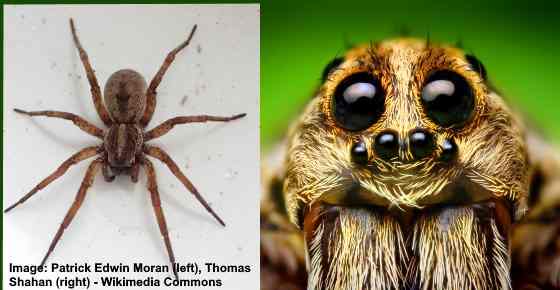
Wolf spiders are common throughout North America and are quite large in size and hairy
Wolf spiders are a subclass of arachnids belonging to the family named Lycosidae. There are thousands of spider species that are classed as 'wolf spiders.' The bodies of these hairy 8-legged creatures grow up to 1.38" (35 mm).
There are a number of ways to identify the common wolf spider in your home. Shining a light on them may cause an eerie glow from their eyes as the light reflects back. Also, wolf spiders are the only species to carry their tiny baby spiders (spiderlings) on their abdomen.
Wolf spiders bite when they are threatened. However, their bite is similar to a bee's sting and may cause itching, swelling, and mild pain.
Wolf spiders get their name from the way that they capture their prey. They don't spin webs but hunt and ambush prey like wolves do.
Identifying features
A type of brown spider with beige markings and quite hairy. In relation to other species of spiders, wolf spiders have large eyes and excellent vision.
You can identify wolf spiders by their distinctive eye pattern. First, you will notice two large eyes in the front of their head. Under those two eyes are a row of four smaller eyes. Wolf spiders also have two more eyes on the top of their head at either side
They are found in most outdoor habitats throughout North America and may come into homes in fall when the weather cools.
The wolf spider species Hogna carolinensis is found in South Carolina.
Brown Recluse Spider

Brown recluse spiders tend to be thinner and less hairy than wolf spiders and their bite is more serious
One of the most dangerous arachnids to find in your home is the brown recluse spider (scientific name: Loxosceles reclusa) from the family Sicariidae. Like with other species of recluse spiders, a bite from one of these brown arachnids can require medical attention.
Spider Facts
Excluding their 8 legs, brown recluse spiders range in size from 0.24" to 0.79" (6 – 20 mm). Due to their violin-shaped markings on their rear, they are also called 'violin spiders,' 'fiddleback spiders,' or 'brown fiddlers.' Their long spindly legs make them look bigger than they actually are.
Unlike most other spiders, brown recluses have 3 pairs of eyes rather than 4. They usually scurry away when they feel threatened but if cornered, they may bite. This can result in serious skin tissue injury if not treated properly.
Identifying features
These spiders can be tiny in size or grow to be large spiders nearly an inch (2.5 cm) long. They are usually light tan to medium brown and some species can be dark brown or gray.
These spiders prefer isolated locations and create webs in garages, woodpiles, sheds, and cellars. They are found in many states in central and eastern U.S. such as Texas, Nebraska, Ohio, Georgia, and Kentucky.
American House Spiders
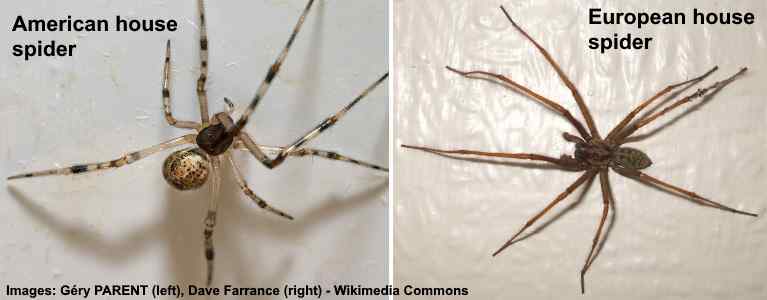
The American and European house spiders are common types of spiders
One of the most common house spiders is the American house spider (Parasteatoda tepidariorum). These brown or tan harmless spiders usually create messy cobwebs to catch their prey.
American house spider facts
These are generally a small species of spider with average body sizes of 0.25" (6 – 7 mm). Although these small house spiders are classed as a type of brown spider, the darker species may resemble black widows. However, dark-colored common household spiders don't have red markings and won't give you nasty bite.
Other species of spiders in other countries are also called 'common house spiders.' The European domestic house spider (Tegenaria domestica) is a brown spider found in Europe. It was also introduced to the US and you can find this house spider in states such as Louisiana, Oregon, Michigan, North Carolina, Washington, and New York.
Identifying features
Found throughout North America, these common spiders are generally found in basements, in attics, behind doors, and in the corners of window frames. The legs of the American house spider are often yellow/orange with dark rings.
Black Widow Spiders
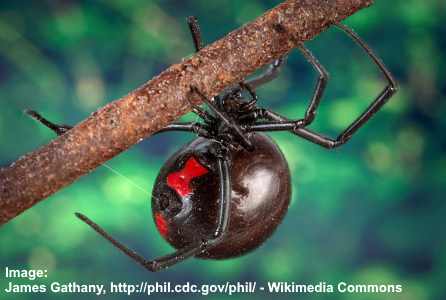
Picture of a female black widow spider (Latrodectus mactans) with red patches on the lower abdomen
Black widow spider is the common name for spiders in the Latrodectus genus belonging to the family Theridiidae. These black spiders with red dots are some of the most venomous house spiders in North America. Another venomous species in the genus is the brown widow spider.
Other species include the European black widows (Latrodectus tredecimguttatus), Australian redback black widows (Latrodectus hasseltii), and South African button spiders.
Spider facts
Black widows are identified by their shiny black body and distinctive red markings. The male species can have a black body with red dots and white bands across their bodies.
Although the female black widow spiders can inflict a nasty bite, the bites rarely cause serious complications. Some common effects of a black widow bite are pain, swelling, and cramping. Species of black widow only bite when trapped and threatened.
Identifying features
Species of black and red widow spiders are found on most continents. The red markings on the lower back abdomen often resemble an hourglass.
The North American black widow spiders are generally found in eastern states and are common in the southern states such as Texas, Louisiana, Florida, Oklahoma, and Arkansas.
Huntsman Spiders
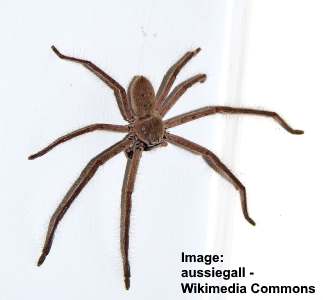
Huntsman spiders have many species and are large with long legs
Huntsman spiders (family: Sparassidae) are appropriately named because of their speed and agility when looking for prey. Some of the larger species are called 'wood spiders' or 'giant crab spider.'
Spider facts
Huntsman spiders are large hairy spiders that can sometimes be mistaken for tarantulas. They have brown/beige or tan-colored bodies and long legs. Usually, the bodies are just under an inch (2 cm) long and their leg span can be as large as 6" (15 cm). The difference between these venomous arachnids and tarantulas is that their front legs resemble a crab's pose.
Sparassidae species can attack and bite humans to defend themselves. Because they tend to lurk in sheds, garages, and under rocks in gardens, an unsuspecting person may disturb one and get a nasty bite.
Identifying features
Over one thousand species of huntsman spiders live in warm countries throughout the world. They have furry bodies and are in various shades of brown or gray.
Hobo Spider
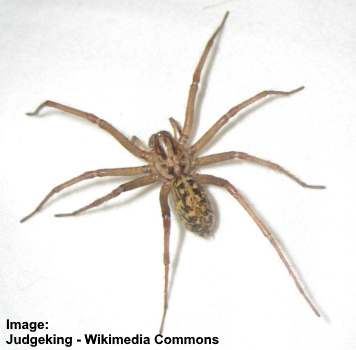
It's often difficult to identify hobo spiders due to their common features and color
The hobo spider (Eratigena agrestis) is a member of the spider genus called Eratigena and is known for its funnel webs. They are also called funnel-web spiders and are a relatively harmless species found in Europe and North America. These brown or beige spiders shouldn't be confused with highly venomous Australian funnel-web spiders (mygalomorphs).
It can be difficult to identify hobo spiders because of their diverse appearance. They are generally small light to dark brown spiders about 0.27" to 0.55" (7 – 14 mm) in length. One way to identify these little brown spiders is by the yellow markings on their abdomen.
Although some class the hobo spider as an aggressive house spider, they only attack and bite if their young are threatened.
Identifying features
Hobo spiders can resemble wolf spiders or brown recluse spiders. They tend to inhabit dark cracks and crevices in homes, outbuildings, garages, and sheds.
White Spiders
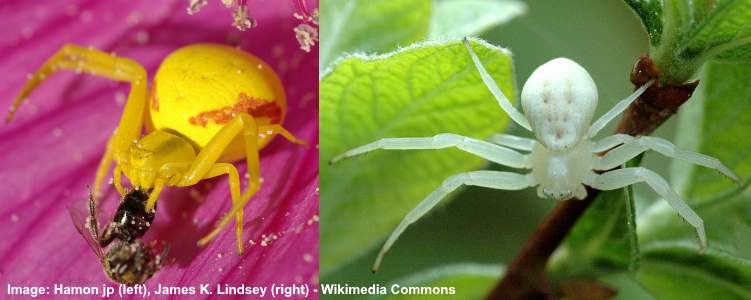
White spiders are small and can turn to bright yellow color
The 'flower crab spider' (Misumena vatia) is a white species of spider in the family Thomisidae. These are an unusual small type of white spider that can change its color. These garden spiders get their common name from the crab-like way they hold their legs.
Color changes of white spiders is a camouflage mechanism to catch their prey. The white spiders can turn bright yellow if they are on yellow flowers. In North America, you can sometimes find these crab spiders on goldenrod flowers. Because of their bright yellow colors, they are also called 'banana spiders.'
Identifying features
These are quite small spiders. Females can grow up to 0.39" (10 mm) excluding legs; males reach half this size at most.
Orb-Weaver Spiders
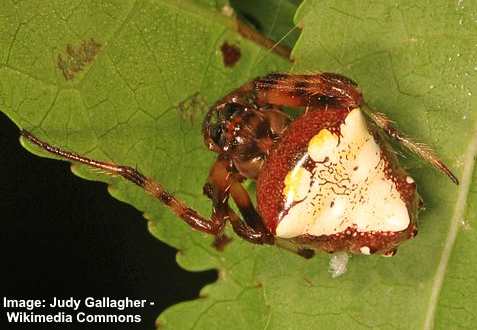
Arrowhead Orb Weaver Spider (Verrucosa arenata) is common in North America in forests, gardens or hiding in dark areas
Some of the most colorful spiders you will find in your garden are orb-weaver spiders. These spiders from the family Araneidae spin some of the most beautiful webs you will come across.
Because all spiders that spin orb (circular) shaped webs are classed as orb-weavers, orb spiders are difficult to categorize as they include many species. Some are oval-shaped with a black and white body and dark red spike-like shapes. Other species can have black bodies with yellow and white markings. Or, an orb-weaver spider could have a large globular colorful body with a small head.
These spiders can also range in size from very small ones to huge spiders that have a leg span as big as your hand.
Identifying features
Harmless spiders that spin intricate webs on flowers, trees, and near electric lights to catch insects.
Jumping Spiders
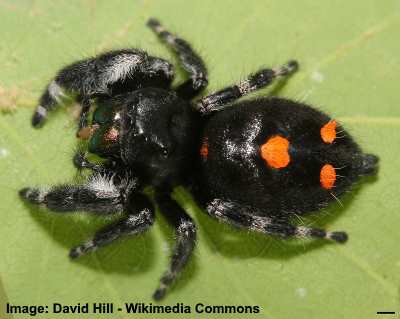
Phidippus audax is a common jumping spider of North America with black body and orange or white spots and stripes on their abdomen and legs
Spiders in the family named Salticidae are called jumping spiders because they jump when moving or hunting. The large eyes on the front of their body mean they also have great eyesight, something rare among other types of spiders.
Jumping spider facts
There are over 6,000 species of jumping spiders divided into 640 genera. Most kinds of jumping spiders have hairy or furry bodies and a distinctly shaped head and thorax. Another way to identify jumping spiders is by their 4 eyes on the front of their head, 2 of which are larger. Their great eyesight allows them to hunt and jump on prey before injecting venom.
Jumping spiders can also be very tiny. Some of the smallest species only measure 0.04" (1 mm) and larger ones are an inch (2.5 cm) long.
Identifying features
These usually small brown spiders are found almost anywhere and can be seen during the daytime.
Sac Spiders
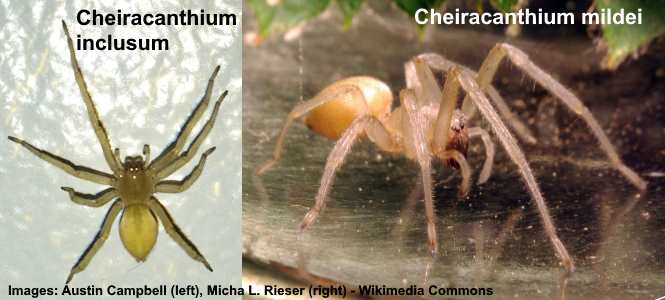
Yellow tiny sac spiders are commonly found in gardens, but come inside homes in cold weather
The name 'sac spiders' can refer to a large number of spiders in the families Clubionidae, Corinnidae, or Eutichuridae.
One of the most common species of sac spiders is the 'yellow sac spider' (Cheiracanthium inclusum and Cheiracanthium mildei). These running spiders are a yellowish-green color and can bite when provoked. The most common reasons for being bitten are disturbing them while working in the garden or if one gets trapped in clothing.
Sac spiders are a garden spider in warm weather and will invade houses in fall as they search for a warmer environment.
These common house spiders are easy to identify as they have a lighter color than brown house spiders.
Identifying features
A tiny species of spider that has a body length of around 0.25" (6 mm) with a distinct light-colored cephalothorax. The name 'sac spider' comes from the fact they tend to live in small spun sacs in corners of rooms and windows in homes, outbuildings, or garages.
Cellar Spiders (Daddy Long-Legs)
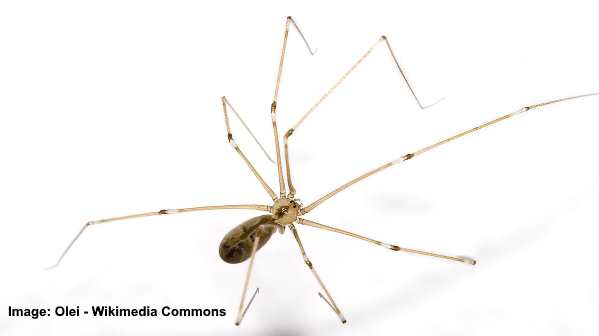
Cellar Spiders are common house spiders. These typical house spiders have long legs and they like to live in dark places
Long-bodied cellar spiders (Pholcus phalangioides) belong to the family Pholcidae. These spiders also have some of the longest legs of any spider in relation to their body. Their long thin spindly legs can be as long as 6 times their body length.
Although these spiders carry venom, they are completely harmless to humans. In fact, they are classed as a beneficial spider because they consume a large number of pests such as flies, mosquitoes, and other flying nuisances. These skinny spiders also kill dangerous spiders such as hobo spiders and redback spiders.
Cellar spiders get their name from the fact they like to live in dark places. You will often find them in garages, on ceilings, in cellars, and in caves. Other names for them include daddy long-legs and skull spiders – this is because their cephalothorax looks like a skull.
Identifying features
Small oval-shaped bodies that are light tan or beige and long skinny legs make this spider species easy to identify.
Grass Spider
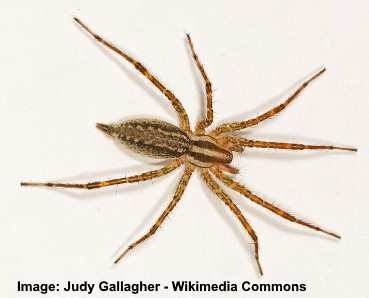
Grass spiders are brown with striped body and are commonly found in gardens
Grass spiders are a species of spider belonging to the family Agelenidae. They are a medium sized brown garden spider with striped markings along the length of its body. When trying to identify this spider, you will notice distinct bands around its legs.
Grass spiders are usually found in lawns, parks, and other grassy areas. They have a venomous bite that is fatal for insects but relatively harmless for humans. Because they are another type of beneficial arachnid, it is best to avoid killing them. They will help to keep down populations of mites and other insects in your garden.
Identifying features
If you find the brown spider scurrying around grass, it is probably a grass spider. It is rare to spot these harmless brown spiders indoors.
Female grass spiders range in length from 0.39″-0.78″ (10-20 millimeters), while males are slightly smaller.
Facts about Golden Silk Spiders
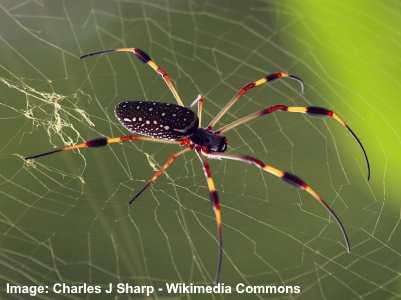
The large Golden silk spider (Nephila clavipes) has long legs with bright colors on the female abdomen
Also called golden silk orb-weavers, these arachnids from the subfamily Nephilinae spin some of the most beautiful webs. Other names for this fascinating spider include 'banana spider' and 'giant wood spider.'
Golden silk spiders are also very colorful spiders that range in color from red to greenish-yellow. Many species also have white markings or spots on their cephalothorax. Another unique fact about this spider species is that they spin yellow-colored webs.
Golden silk orb-weavers are also some of the largest garden spiders you will find in warmer climates. The females can grow as long as 2" (50 mm), not counting the length of their super-long legs. Some Asian species of banana spiders have been recorded at over 5" (130 mm) long!
Identifying features
These large spiders in North America are found in southeastern states such as the Carolinas, Florida, and can even be found in Texas, Louisiana, and Georgia.
To identify these interesting spiders, look for their long orange or dark tan shaped body with white spots.
Learn about common garden spiders and how to identify them.
Related articles:
- Types of Black Spiders With Pictures and Identification Guide
- Types of Animals: Classes, Species, Categories and More
Read Next
Black Spider With One White Stripe on Back
Source: https://leafyplace.com/types-of-spiders-and-identification/
0 Response to "Black Spider With One White Stripe on Back"
Enregistrer un commentaire